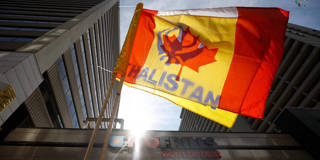Canadian Prime Minister Justin Trudeau's recent claim that India’s government might be linked to the fatal shooting of a Sikh separatist on Canadian soil has sent bilateral relations into a tailspin. Even if the current tensions ease, Canada's refusal to rein in Sikh separatism will continue to fuel tension.
NEW DELHI – Rarely have two major democracies descended into as ugly a diplomatic spat as the one now unfolding between Canada and India. With the traditionally friendly relationship already at its lowest point ever, both sides are now engaging in quiet diplomacy to arrest the downward spiral, using the United States, a Canadian ally and Indian partner, as the intermediary. But even if the current diplomatic ruckus eases, Canada’s tolerance of Sikh separatist activity on its territory will continue to bedevil bilateral ties.
The current dispute began when Canadian Prime Minister Justin Trudeau sensationally claimed that there were “credible allegations” about a “potential link” between India’s government and the fatal shooting in June of Hardeep Singh Nijjar, a Sikh separatist and Canadian citizen, on Canadian soil. India’s government fired back by demanding that Canada reduce its diplomatic staff in India, suspending new visas for Canadians, and accusing Canada of making “absurd” accusations to divert attention from its status as “a safe haven for terrorists.”
Nijjar was hardly the only Sikh separatist living in Canada. In fact, the country has emerged as the global hub of the militant movement for “Khalistan,” or an independent Sikh homeland. The separatists constitute a small minority of the Sikh diaspora, concentrated in the Anglosphere, especially Canada. Sikhs living in India – who overwhelmingly report that they are proud to be Indian – do not support the separatist cause.

NEW DELHI – Rarely have two major democracies descended into as ugly a diplomatic spat as the one now unfolding between Canada and India. With the traditionally friendly relationship already at its lowest point ever, both sides are now engaging in quiet diplomacy to arrest the downward spiral, using the United States, a Canadian ally and Indian partner, as the intermediary. But even if the current diplomatic ruckus eases, Canada’s tolerance of Sikh separatist activity on its territory will continue to bedevil bilateral ties.
The current dispute began when Canadian Prime Minister Justin Trudeau sensationally claimed that there were “credible allegations” about a “potential link” between India’s government and the fatal shooting in June of Hardeep Singh Nijjar, a Sikh separatist and Canadian citizen, on Canadian soil. India’s government fired back by demanding that Canada reduce its diplomatic staff in India, suspending new visas for Canadians, and accusing Canada of making “absurd” accusations to divert attention from its status as “a safe haven for terrorists.”
Nijjar was hardly the only Sikh separatist living in Canada. In fact, the country has emerged as the global hub of the militant movement for “Khalistan,” or an independent Sikh homeland. The separatists constitute a small minority of the Sikh diaspora, concentrated in the Anglosphere, especially Canada. Sikhs living in India – who overwhelmingly report that they are proud to be Indian – do not support the separatist cause.